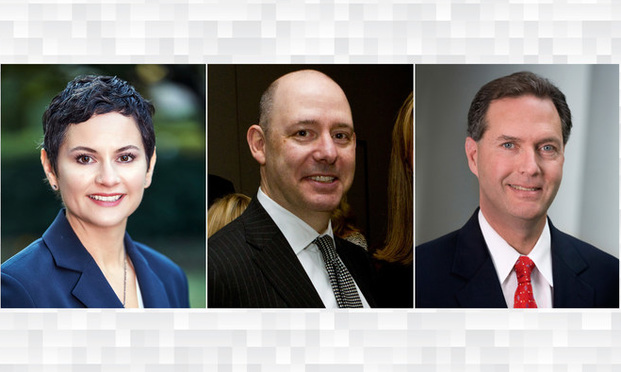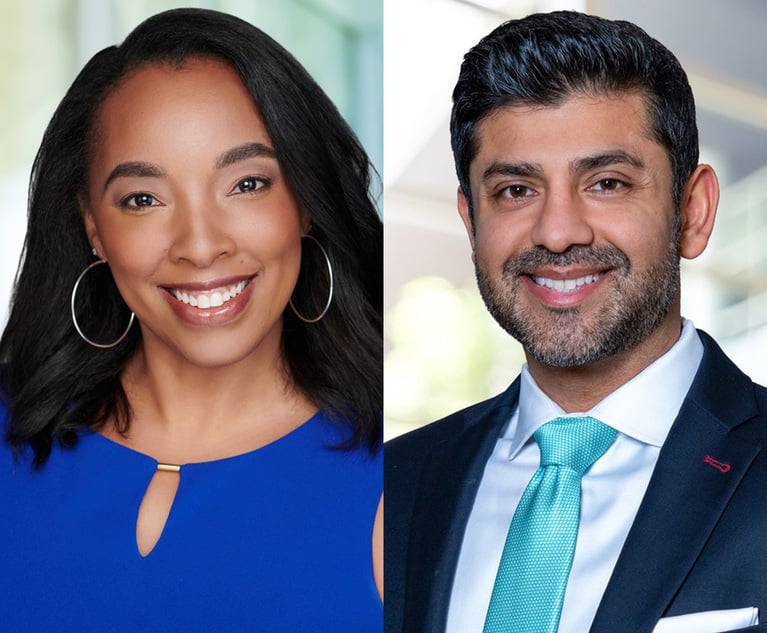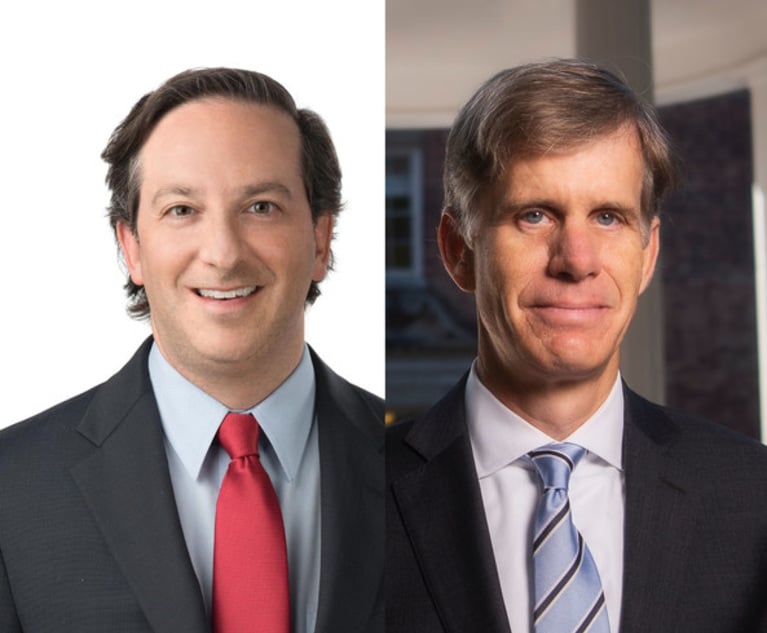Rainmakers-in-Training Need Time to Train, Experts Say
"The best place to meet clients is where the clients are," said one law firm partner.
May 15, 2018 at 12:36 PM
4 minute read

Marketing. Client development. Rainmaking.
No matter what words describe it, the business of getting more business is a constant pressure in law firms. Stephanie Friese said training new lawyers must include making time for this goal.
“We need to create a space so younger attorneys can build a book of business,” said Friese, managing partner of Pursley Friese Torgrimson, a 12-lawyer firm that handles a host of commercial real estate matters.
She said her firm requires lawyers to bill 1,650 hours per year, on the lower side of the market—but they need 300 hours of business development on top. “We track those hours,” she said.
Friese referred back to her experience as a new lawyer trying to start her own firm. She threw herself into meeting people in the industry she wanted to serve, eventually getting involved in Commercial Real Estate Women of Atlanta. There she met in-house counsel and served on committees.
“Make sure what you're involved in puts you on the leadership path,” she noted.
At a much bigger firm, 165-lawyer Arnall Golden Gregory, partner Michael Golden takes a similar approach, saying the firm encourages lawyers to get involved in business organizations.
“The best place to meet clients is where the clients are,” said Golden, who co-leads the firm's closely held and family business practice. But he cautioned that lawyers don't attend, for example, a trade association meeting to look for clients. Instead, one goes to demonstrate knowledge of the law that affects that industry.
Like Friese, Golden noted that participating in associations and committees pays off best when its substantial enough to earn a place of leadership. That kind of work—recruiting speakers and identifying important issues—gives lawyers opportunities to showcase their expertise.
And the firm gives associates credit for time spent involved in marketing and business development, he added.
At 195-lawyer Morris, Manning, & Martin, John Yates said the firm has a guideline to help train rainmakers: “Never have a meal with a prospective client or strategic partner without an MMM colleague.”
“Attorneys are observant, and it's amazing how often younger colleagues learn from seasoned business development veterans,” he added. “They often pick up, by osmosis, key pointers that help them win a new client. And lawyers hunting for new business are more likely to be successful through teamwork.”
Yates, who heads the firm's technology practice, added that for the past several years, the entire corporate tech group has met—associates and partners—to review current business development projects, prospect pipelines and key metrics (new clients and outstanding prospects).
Those meetings include case studies on how the team gained a new client and a review of upcoming events that will be of interest to clients and prospects. The firm has also started videotaping business development presentations for internal viewing.
“We believe they'll prove to be very helpful in the training process,” Yates added.
Friese was asked whether any of this training can walk out the door when a lawyer with a freshly built book of business goes to a new firm.
“It definitely happens,” she said, but she added, “It's a risk we have to take when we grow.”
For more business of law coverage exclusively geared toward midsize firms, sign up for a free trial of ALM's new weekly newsletter, The Mid-Market Report.
This content has been archived. It is available through our partners, LexisNexis® and Bloomberg Law.
To view this content, please continue to their sites.
Not a Lexis Subscriber?
Subscribe Now
Not a Bloomberg Law Subscriber?
Subscribe Now
NOT FOR REPRINT
© 2025 ALM Global, LLC, All Rights Reserved. Request academic re-use from www.copyright.com. All other uses, submit a request to [email protected]. For more information visit Asset & Logo Licensing.
You Might Like
View All


On The Move: Ex-Partner Returns to Lead Nelson Mullins Corporate Group, Burr & Forman Hires University GC as COO
5 minute read
Law Firm Sued for Telemarketing Calls to Customers on Do Not Call Registry
Trending Stories
- 1Midsize Firm Bressler Amery Absorbs Austin Boutique, Gaining Four Lawyers
- 2Bill Would Allow Californians to Sue Big Oil for Climate-Linked Wildfires, Floods
- 3LinkedIn Suit Says Millions of Profiles Scraped by Singapore Firm’s Fake Accounts
- 4Supreme Court Agrees to Hear Lawsuit Over FBI Raid at Wrong House
- 5What It Takes to Connect With Millennial Jurors
Who Got The Work
J. Brugh Lower of Gibbons has entered an appearance for industrial equipment supplier Devco Corporation in a pending trademark infringement lawsuit. The suit, accusing the defendant of selling knock-off Graco products, was filed Dec. 18 in New Jersey District Court by Rivkin Radler on behalf of Graco Inc. and Graco Minnesota. The case, assigned to U.S. District Judge Zahid N. Quraishi, is 3:24-cv-11294, Graco Inc. et al v. Devco Corporation.
Who Got The Work
Rebecca Maller-Stein and Kent A. Yalowitz of Arnold & Porter Kaye Scholer have entered their appearances for Hanaco Venture Capital and its executives, Lior Prosor and David Frankel, in a pending securities lawsuit. The action, filed on Dec. 24 in New York Southern District Court by Zell, Aron & Co. on behalf of Goldeneye Advisors, accuses the defendants of negligently and fraudulently managing the plaintiff's $1 million investment. The case, assigned to U.S. District Judge Vernon S. Broderick, is 1:24-cv-09918, Goldeneye Advisors, LLC v. Hanaco Venture Capital, Ltd. et al.
Who Got The Work
Attorneys from A&O Shearman has stepped in as defense counsel for Toronto-Dominion Bank and other defendants in a pending securities class action. The suit, filed Dec. 11 in New York Southern District Court by Bleichmar Fonti & Auld, accuses the defendants of concealing the bank's 'pervasive' deficiencies in regards to its compliance with the Bank Secrecy Act and the quality of its anti-money laundering controls. The case, assigned to U.S. District Judge Arun Subramanian, is 1:24-cv-09445, Gonzalez v. The Toronto-Dominion Bank et al.
Who Got The Work
Crown Castle International, a Pennsylvania company providing shared communications infrastructure, has turned to Luke D. Wolf of Gordon Rees Scully Mansukhani to fend off a pending breach-of-contract lawsuit. The court action, filed Nov. 25 in Michigan Eastern District Court by Hooper Hathaway PC on behalf of The Town Residences LLC, accuses Crown Castle of failing to transfer approximately $30,000 in utility payments from T-Mobile in breach of a roof-top lease and assignment agreement. The case, assigned to U.S. District Judge Susan K. Declercq, is 2:24-cv-13131, The Town Residences LLC v. T-Mobile US, Inc. et al.
Who Got The Work
Wilfred P. Coronato and Daniel M. Schwartz of McCarter & English have stepped in as defense counsel to Electrolux Home Products Inc. in a pending product liability lawsuit. The court action, filed Nov. 26 in New York Eastern District Court by Poulos Lopiccolo PC and Nagel Rice LLP on behalf of David Stern, alleges that the defendant's refrigerators’ drawers and shelving repeatedly break and fall apart within months after purchase. The case, assigned to U.S. District Judge Joan M. Azrack, is 2:24-cv-08204, Stern v. Electrolux Home Products, Inc.
Featured Firms
Law Offices of Gary Martin Hays & Associates, P.C.
(470) 294-1674
Law Offices of Mark E. Salomone
(857) 444-6468
Smith & Hassler
(713) 739-1250






